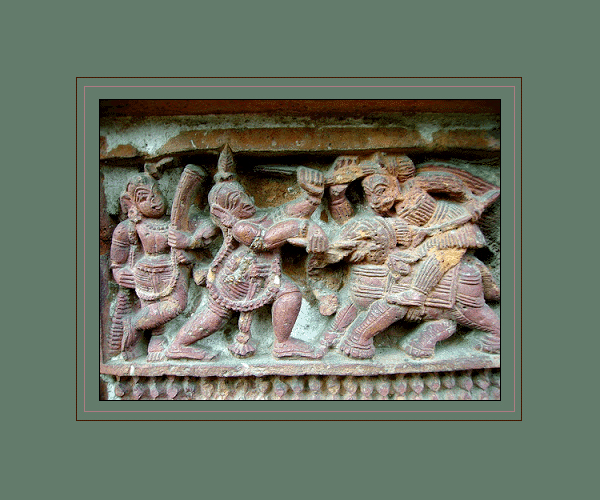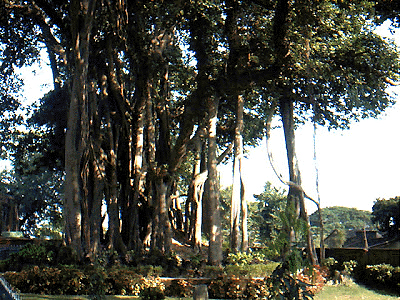
|
|
|
|
BY: SUN STAFF

Mahabharata Scene Jul 05, 2014 — CANADA (SUN) — A serial presentation of the holy places mentioned in the Jaiva Dharma of Srila Bhaktivinoda Thakur - Part 138.
In a manuscript entitled Sree Krishna Chaitanya by one of Srila Bhaktisiddhanta's disciples, Sri Narayan Das Bhakti Sadhukar (Prof. N. K. Sanyal, M.A) of Cuttack, there is a story about Srila Raghunatha Dasa Goswami, whose father and uncle were tax collectors in Saptagrama:
"From Benapole Thakur Haridas proceeded to Chandpur eastward of Saptagrama, the residence of the father of the future Raghunath das Goswami who was at this time a little boy. The name of Raghunath's father was Gobardhan Mazumdar. Hiranya was the elder brother of Gobardhan. They were employed under Sultan Hussain Shah to collect the revenues of Saptagrama, which totaled twenty lakhs of rupees of which twelve had to be remitted to the Royal Treasury, the collectors being entitled to retain for themselves the balance of eight lakhs. They were consequently among the richest persons of that time. Thakur Haridas put up with Balaram Acharya of Chandpur who was the priest of Hiranya and Gobardhan. The boy Raghunath Das frequently visited Thakur Haridas. This was the cause of his obtaining the mercy of Sree Chaitanya later on."
While Professor Sanyal quotes a certain percentage of tax distribution, Srila Prabhupada specifies a different figure in his purport to Caitanya-caritamrta Antya 6.17:
hena-kāle mulukera eka mleccha adhikārī "At that time there was a Muslim official collecting the taxes of Saptagrāma.
Purport: Formerly, when the Muslim government was in power, the person appointed tax collector would collect the taxes of the local zamindars, or landholders. He would keep one fourth of the collection for himself as a profit, and the balance he would deliver to the treasury of the government."

Banyana Tree at Saptagrama In Renunciation Through Wisdom, chapter three, there is a narration by Srila Prabhupada of Haridas Thakur's pastime involving a debate arranged by an employee of Raghunatha Dasa's father. This exchange took place at Saptagrama: koṭi-janme brahma-jñāne yei 'mukti' naya After many millions upon millions of births, when one is complete in absolute knowledge, one still may not attain liberation, yet this man says that one may attain it simply by the awakening of a glimpse of the holy name.
Śrīla Raghunātha dāsa Gosvāmī's father and uncle—Hiraṇya Majumdara and Govardhana Majumdara, respectively—were big landowners of the ancient village of Cāndapura at Saptagrāma. One of their employees, a Argumentative impersonalists fail to grasp that without first properly understanding the science of the Absolute Truth, one cannot possibly develop firm devotion to the Supreme Lord. Hence when a person is seen to be situated on the platform of pure devotional service, it is to be understood that his ignorance has been destroyed. We have discussed this point in some detail in the previous essay, " Unfortunately, the stubborn impersonalists cannot comprehend that the final spiritual destination, beyond even the four Vedic goals (religiosity, economic development, sense gratification, and liberation) is absolutely pure and transcendental love of Godhead. They mistake the devotees of the Lord for sentimentalists and consider them their philosophical opponents. Besides these out-and-out impersonalists, there is a certain group of devotees that has deviated from the path of pure devotion and fallen prey to pretension. These cheaters actually end up following the impersonalists' path of trying to merge with the Supreme Lord. Such materialistic sentimentalists are not counted among the devotees of the Lord. Lord's name, form, qualities, pastimes, associates, or paraphernalia, for they wrongly consider these transcendental subjects illusory. They act capriciously and confuse the mass of people.
These materialistic sentimentalists reject the spiritual conclusions of Śrīla Rūpa Gosvāmī and try and take shelter of impersonalism. Yet they miserably lack the scholarship and discipline of the impersonalists. They divorce themselves from the impersonalists' scriptural studies and philosophical discussions, regarding discussions on the scripture as dry speculation and their ignorant, sentimental outbursts as spontaneous devotional fervour.
Some of these pretenders very closely follow in the impersonalists' footsteps and so may be accepted as a deranged offshoot of the impersonalist line. But they are certainly not part of the Vaiṣṇava discipline followed by those in the line of Śrīla Rūpa Gosvāmī."
| |